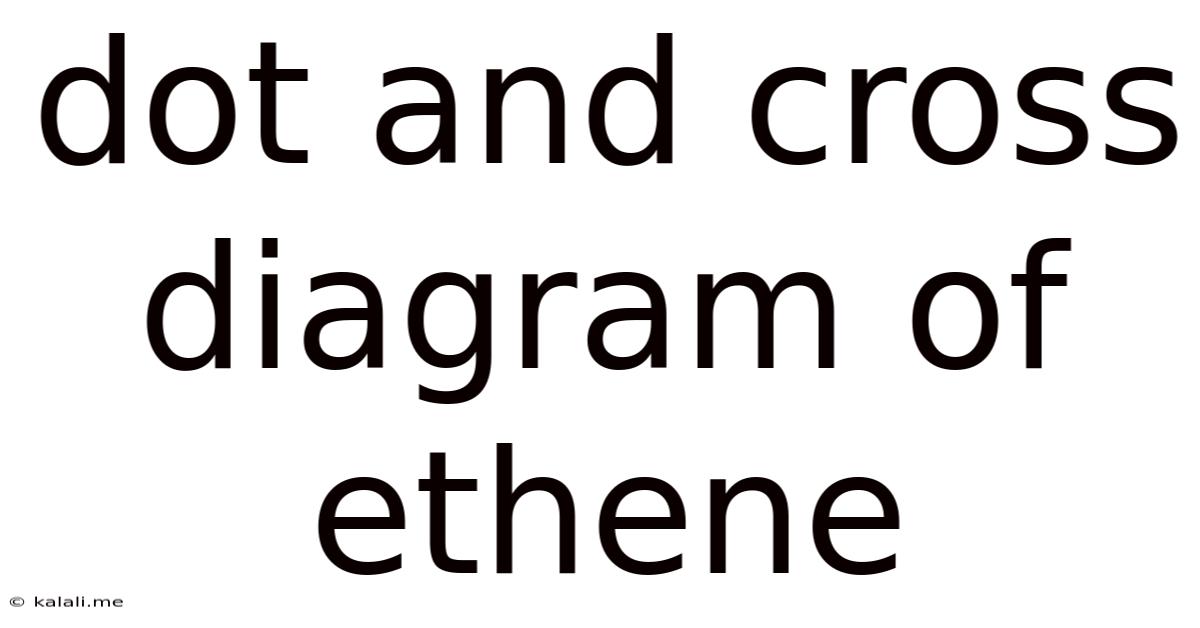Dot And Cross Diagram Of Ethene
Kalali
Jun 11, 2025 · 3 min read

Table of Contents
Understanding the Dot and Cross Diagram of Ethene: A Comprehensive Guide
Ethene, also known as ethylene, is a simple alkene with the chemical formula C₂H₄. Understanding its structure is crucial for grasping its chemical properties and reactivity. This article will delve into creating and interpreting the dot and cross diagram of ethene, explaining the bonding and electron arrangement within the molecule. We will also touch upon the implications of its unique structure.
What is a Dot and Cross Diagram?
A dot and cross diagram, also known as a Lewis structure, is a simple visual representation of the arrangement of electrons in a molecule. It shows how atoms share electrons to form covalent bonds, satisfying the octet rule (except for hydrogen, which only needs two electrons). Each dot or cross represents a valence electron, with dots and crosses often used to distinguish between electrons originating from different atoms.
Constructing the Dot and Cross Diagram of Ethene
Ethene has two carbon atoms and four hydrogen atoms. To construct the dot and cross diagram:
-
Determine the Valence Electrons: Carbon has four valence electrons, and hydrogen has one. Therefore, two carbons contribute 8 electrons (4 x 2), and four hydrogens contribute 4 electrons (1 x 4). The total number of valence electrons is 12.
-
Arrange the Atoms: Place the two carbon atoms in the center, bonded to each other. Each carbon atom will then bond with two hydrogen atoms. This arrangement creates a skeletal structure.
-
Distribute the Electrons: Begin by placing electrons between the atoms to form single bonds. Each single bond requires two electrons. Connect each carbon to its two hydrogens using single bonds. This uses 8 electrons (4 bonds x 2 electrons/bond).
-
Satisfy the Octet Rule: Each carbon atom currently only has 8 electrons. To satisfy the octet rule for both carbon atoms, add a double bond between the two carbon atoms. This adds 2 more electrons between the carbons, using the remaining 4 electrons.
The final dot and cross diagram should show:
- A single bond between each carbon and its two hydrogen atoms.
- A double bond between the two carbon atoms.
- All atoms (except hydrogen) having a complete octet of electrons.
This double bond is a key feature of ethene, and it accounts for many of its properties.
Significance of the Double Bond in Ethene
The double bond in ethene consists of one sigma (σ) bond and one pi (π) bond. The sigma bond is formed by the direct overlap of atomic orbitals, while the pi bond is formed by the sideways overlap of p-orbitals. This double bond is stronger than a single bond, resulting in a higher bond energy and shorter bond length between the carbon atoms compared to ethane (C₂H₆). The presence of the pi bond also makes ethene more reactive than alkanes, due to its ability to undergo addition reactions.
Applications and Further Exploration
Understanding the dot and cross diagram of ethene is foundational to understanding its chemical behavior and its wide range of applications in the chemical industry. From the production of plastics (polyethylene) to its use as a ripening agent for fruits, ethene's properties stem directly from its unique molecular structure. Further studies can involve investigating the molecular geometry (planar structure) of ethene and exploring its reactions, like addition and polymerization reactions.
This comprehensive guide provides a clear understanding of how to construct and interpret the dot and cross diagram of ethene, highlighting its significance in chemistry. Remember to always practice drawing these diagrams to solidify your understanding of chemical bonding.
Latest Posts
Latest Posts
-
How Many Cups In A 16 Oz Sour Cream
Jul 02, 2025
-
How Many 1 4 Teaspoons Are In 1 Teaspoon
Jul 02, 2025
-
How Many Tbsp In A Dry Ounce
Jul 02, 2025
-
How Do You Say Grandparents In Spanish
Jul 02, 2025
-
How Many Numbers Are Between 48 To 24
Jul 02, 2025
Related Post
Thank you for visiting our website which covers about Dot And Cross Diagram Of Ethene . We hope the information provided has been useful to you. Feel free to contact us if you have any questions or need further assistance. See you next time and don't miss to bookmark.